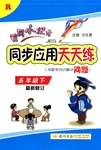题目内容
Three soldiers were killed and five badly ________in the battle.
A.damaged B.wounded C.ruined D.destroyed
B

 黄冈小状元同步计算天天练系列答案
黄冈小状元同步计算天天练系列答案On the day Apple debuted the often-delayed white-colored iPhone 4, the company’s marketing department gave a nod to the product’s troubled history.
“Finally.” read the big headline Thursday above a picture of the white phone on the homepage of Apple. com.
The white model was supposed to ship alongside the black one at the iPhone 4’s launch(推出) last June. But design and manufacturing complications delayed the process by 10 months, catching Apple off guard, executives say.
As CNN reported last month, earlier test models of the white iPhone 4 produced unclear photos, especially when the flash(闪光灯) was used. Its whiteness confused the proximity sensor (距离传感器) , which detects when the phone is held next to someone’s head and turns off the touch screen to save battery life.
These problems weren’t present in older iPhones that came in white because they didn’t have flash photography; the proximity sensor was unaffected because the front side of previous models was black.
“We thought we were there a year ago, or less than that, when we launched the iPhone 4, and we weren’t,” Philip Schiller, Apple’s chief marketing executive, said in an interview. “It’s not as simple as making something white. There’s a lot more that goes into both the material science of it —how it holds up over time…but also in how it all works with the sensors. “
Ticonderoga Securities analyst Brian White predicts that the white model could help drive sales of Apple’s phones. He says Apple could sell 1 million to 1. 5 million every three months until the next iPhone model is unveiled, which is expected to be this fall.
Forty-five people were lined up at Apple’s flagship New York store Thursday morning to buy white iPhones, according to a CNN Money report.
1.
The reason why white-colored iPhone 4 was delayed by 10 months is that _______.
|
A.it’s always sold out due to its popularity |
|
B.it met some problems concerning design and manufacture |
|
C.it lacked white manufacturing materials |
|
D.its proximity sensor can’t save battery life |
2.
According to the passage, which of the following statements is TRUE?
|
A.There are multi-colored models of iPhone 4. |
|
B.The same design problems were also found in older white iPhones. |
|
C.IPhone4 will be launched this fall. |
|
D.Originally designers thought they could solve the problems before iPhone 4 was launched. |
3.
What would be the best title for this passage?
|
A.Why the White iPhone 4 Took So Long |
|
B.The History of iPhone 4 |
|
C.The Attraction of White iPhone 4 |
|
D.The Design and Manufacture of iPhone 4 |
4.
What does the underlined word “unveil” in the last paragraph mean?
|
A.to remove one’s mask from his face |
|
B.to remove a cloth from something, especially as part of a ceremony |
|
C.to show to the public for the first time |
|
D.to disappear from the public for the first time |